In the acclaimed 1950 movie, All About Eve, Bette Davis’ character, Margo Channing, launches her cocktail party by downing a Gibson and uttering the famous line, “Fasten your seat belts, it’s going to be a bumpy night.”
Though a tipsy Margo ends up ruining the party with her increasing bitterness, she looks sensational the whole time in her glamorous cocktail dress. Made of brown gros de Londres (heavy silk that photographs well in black and white) and trimmed in rich brown sable, the dress is one of the most iconic film dresses of all time.
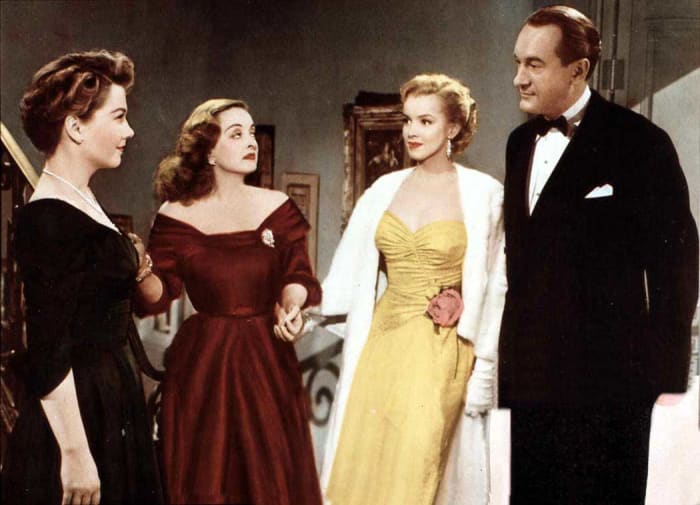
Bette Davis, second from left, wearing the iconic cocktail dress in the 1950 classic, All About Eve. Also pictured are Anne Baxter, far left, and Marilyn Monroe, and George Sanders, The dress was made by famed designer Edith Head, who won an Oscar for Best Costume Design for the movie.
Universal History Archive/Getty Images
In Edith Head’s Hollywood, Head said for that pivotal movie moment, she envisioned the iconic cocktail-dress silhouette of 1950. That silhouette was heavily influenced by the “New Look” collection French designer Christian Dior debuted in 1947, and which was still considered the height of fashion: a tight bodice, belted waist, and calf-length full skirt.
In fact, in the late 1940s, Dior was the first to dub dresses worn in the early evening as “cocktail” dresses. But women were turning heads in other glamorous creations worn for cocktails long before then as they began exercising their freedom to drink alcohol in public.
With the festive party season upon us to dress up and drink, we’re taking a look at the history of women’s cocktail attire.
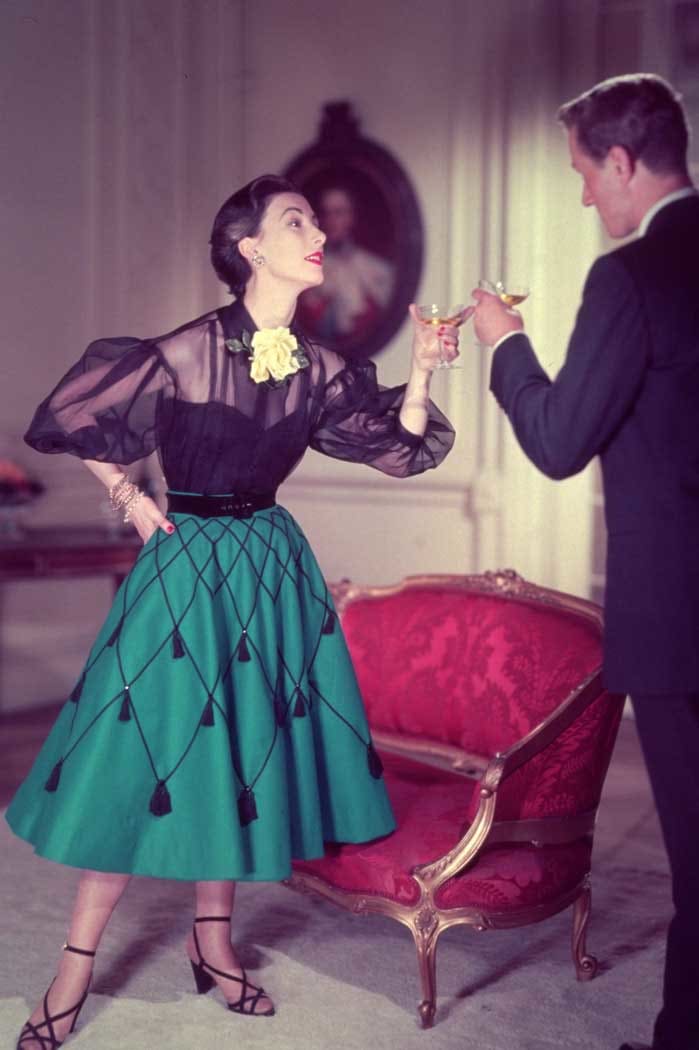
The cocktail dress was valued for its functionality and flexibility. It bridged the gap between day and night, making women look not too polished during the day and not overly casual during early evening festivities.
Photo by Hulton Archive/Getty Images
Just Add Cocktails
Cocktail dresses would not have existed without the popularity of cocktails themselves. There is debate about the origins of the word cocktail, but in the United States, the first written mention of it as a beverage appeared in The Farmers Cabinet in 1803. In 1806, The Balance and Columbian Repository made the first reference to a cocktail as an alcoholic beverage.
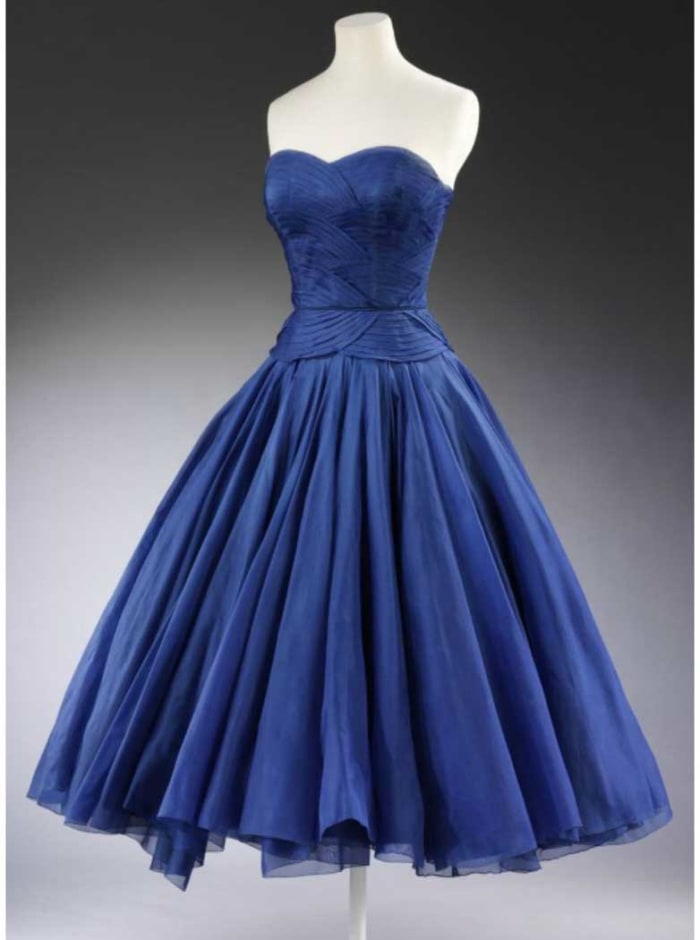
Princess Margaret, Countess of Snowdon, wore this blue silk cocktail dress in 1951. Designed by Jean Dessès, the overlapping, curved pleats formed into scalloped panels on this bodice front suggest a stylized rendition of receding waves.
Victoria and Albert Museum
Cocktails became increasingly popular in America and Europe throughout the 1800s, but Victorian women would not have dared imbibe in public, and they definitely wouldn’t wear a dress named after a boozy drink. By the 1910s, it became somewhat more acceptable for women to indulge in a few mixed drinks, and cocktail culture began to take root after World War I.
Sophisticated Twenties
Amid the private cocktail soirees and lounges in the late 1920s emerged the modern “drinking woman,” accompanied by her always-designated plus one: the cocktail dress — a shorter evening dress with matching shoes, gloves, and hat.
Fashion historian Elyssa Schram Da Cruz says that with the help of liberation parties like the Women’s Organization for National Prohibition Reform, this modern woman became more visible in the social drinking realm by 1929. Like happy hour today, cocktail time typically took place between 6 p.m. and 8 p.m., and cocktail dresses became the uniform for progressive women, swinging to the sounds of jazz and clinking glasses.
Cocktail attire was valued for its functionality and flexibility. It bridged the gap between day and night, making women look not too polished during the day and not overly casual in the early evening. While a day outfit typically was unadorned, a cocktail dress was worn with coordinating accessories. And a drink, of course.
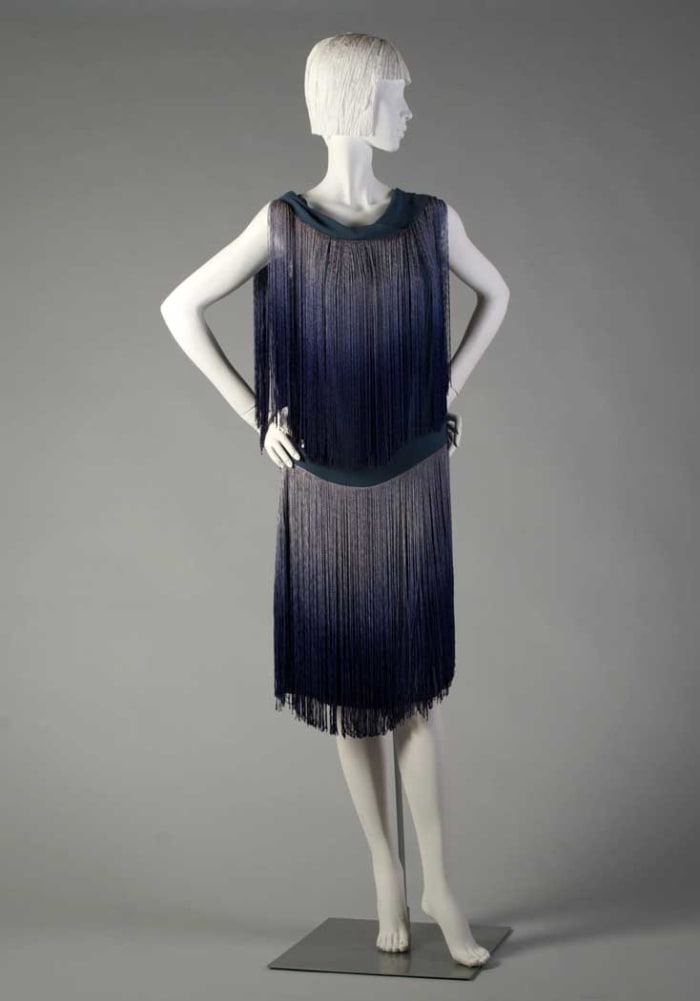
Though this Coco Chanel silk chiffon dress was designed in 1926, it would have perfectly suited a cocktail party, its fringe swinging freely to the sounds of jazz and clinking glasses.
Courtesy of Kent State University Museum
French designer Coco Chanel’s acclaimed calf-length dresses of the mid-1920s, straight and simple in design, became popular with the sophisticated cocktail crowd for the rest of the decade and into the Great Depression.
Prohibition banned alcohol sales from 1920 to 1933, but millions of Americans continued to drink. Most got their liquor fixes at illegal speakeasies, while the upper class had drinking parties at home. Wealthy women took shopping trips to Cuba, London, and Paris, bringing worldwide cocktail culture back to the States and all the private parties they attended.
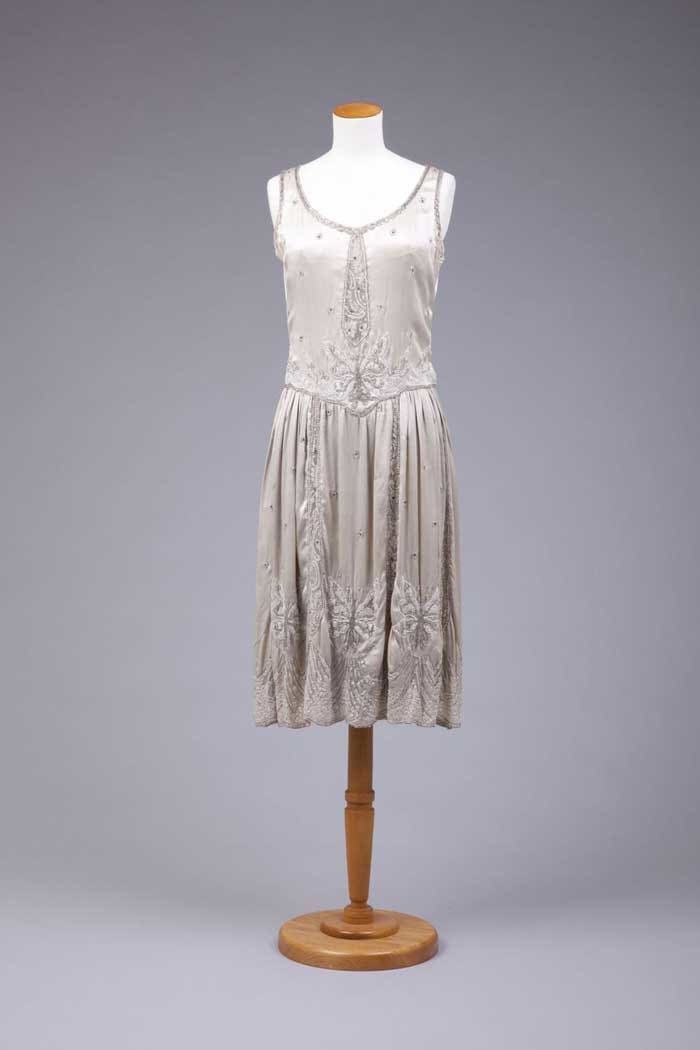
Cocktail dresses such as this platinum silk satin beaded one, circa 1928-1932, would have been worn to cocktail parties everywhere.
Courtesy of the Goldstein Museum of Design/University of Minnesota
But while the elite was promoting European couture’s exclusive designs, most of the United States relied on the advertisements in fashion magazines like Vanity Fair and Vogue, as well as American department stores, that showed how to dress for the cocktail hour. Though cocktail attire featured modest necklines, longer sleeves, and scant embellishment of daytime clothing, it became distinguished by its materials, such as in evening satins and silks, instead of gabardines and wool crepes.
Transitional Thirties
The carefree nature of the Roaring Twenties halted with the stock market crash of 1929. The economic hardships of the early 1930s inspired American designers to create clothes that transitioned from day to night. The hems of cocktail dresses were lowered to the ankles, and designers advocated for a simple, sleek silhouette and championed accessories. Fedoras and cartwheel hats, with their stiff, wide brims and flat, shallow crowns, were both acceptable for cocktails. Though longer than in the 1920s, gloves continued to be a must. Costume jewelry also became the ultimate cocktail accessory, whether a brooch or a full parure.
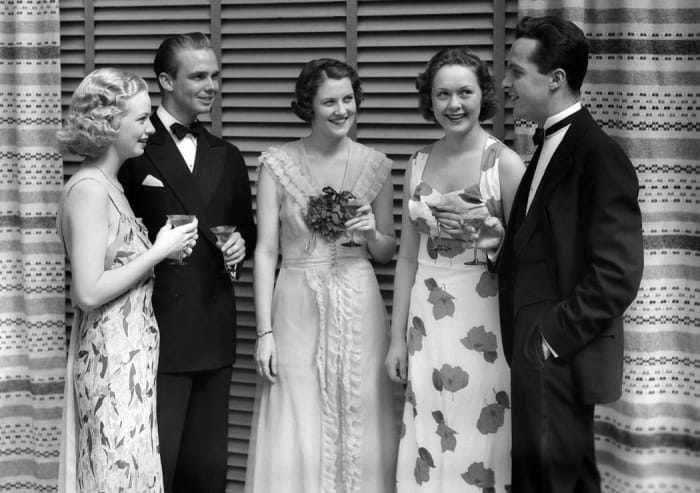
Private cocktail parties of the 1930s could well feature men in tuxedoes and women in simple, sleek silhouette dresses.
H. Armstrong Roberts/ClassicStock/Getty Images
The more privatized cocktail parties of the movies also began to become more popular than the dance clubs of New York and the smoking rooms of Paris. Chanel, Jean Patou, and Elsa Schiaparelli also helped popularize the dressy cocktail suit that could transition from tea in the afternoon to an intimate evening soiree.
‘New Look’ Forties
By the mid-1940s, cocktail clothing’s adaptability and the indispensable cocktail accessory’s availability made cocktailing easy. Parisian milliners produced elegant creations for the cocktail hour with black silk net veils. American designer Norman Norell added rhinestone buttons to “billiard” green and “vodka” gray day suits to designate them as cocktail attire. Hemlines of cocktail dresses also rose to calves during World War II.
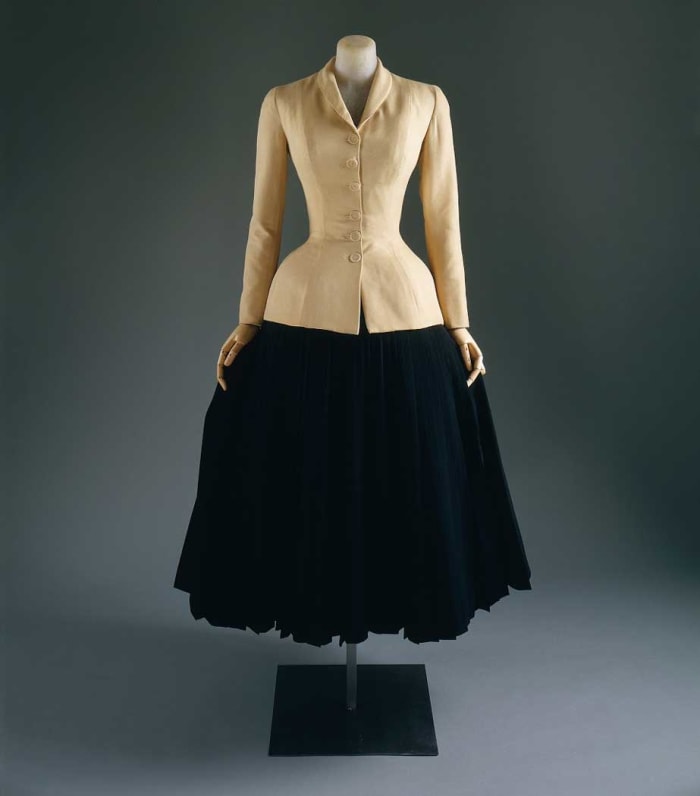
Christian Dior’s “Bar” suit was part of his “New Look” collection of 1947 that revolutionized fashion. It also influenced the classic silhouette of cocktail dresses in the 1950s: a tight bodice, belted waist, and calf-length full skirt.
Courtesy of the Metropolitan Museum of Art
When the war ended, the popularity of at-home cocktail parties rejuvenated the cocktail dress, and Dior’s “New Look” in 1947 highly influenced women’s clothing in the Western world. The universal silhouette for formal dressing became a full skirt and cinched waist. Marilyn Monroe and other actresses also popularized form-fitting sheath dresses they wore in movies. After Dior famously came up with the term cocktail dress, it increased the attire’s popularity by the end of the decade. The terminology was also a clever marketing tool to attract alcohol-loving American clients who enjoyed hosting and dressing for cocktail hours.
Fashionable Fifties
During this decade, cocktail hours and parties had become integral to social life and many believe the 1950s are the age of the cocktail dress. To have a piece of high-end cocktail culture, American women snapped up budget-friendly copies of garments that French couturiers continued to design in a wide range of colors and styles.
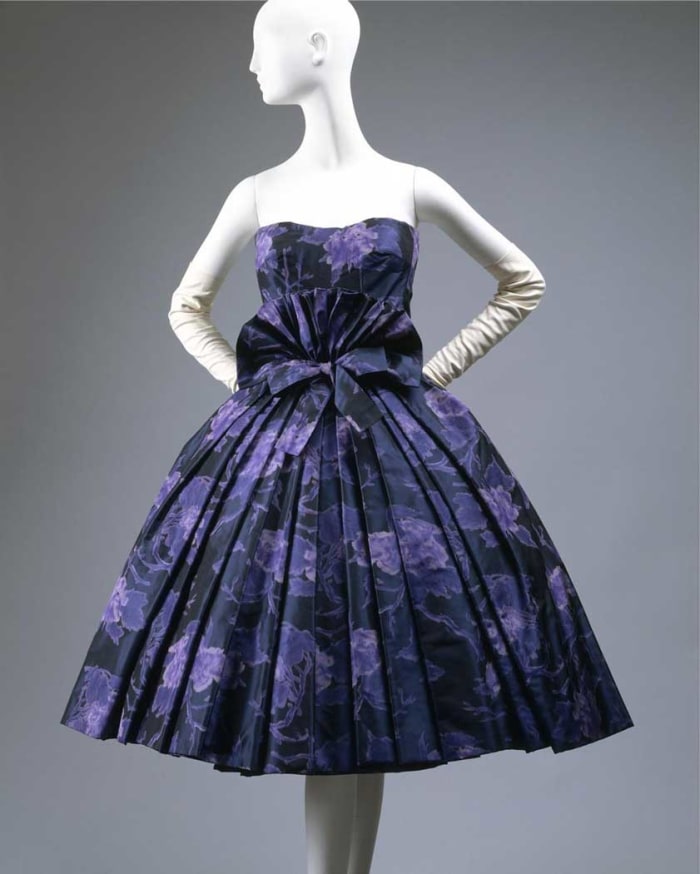
Christian Dior’s silk “Eventail” cocktail dress, fall/winter 1956-57. According to the Metropolitan Museum of Art, this piece is unarguably the 1950s moderne of the cocktail hour. With a strapless neckline and colorful surface print, the dress would have been rejected for the early evening prior to the 1950s, as its various components belonged to late evening or daytime dressing. But by mid-century, it was a welcome addition to any cocktail-clad hostess’ wardrobe.
Courtesy of the Metropolitan Museum of Art
Cocktail culture also helped define women’s domesticated roles as wives, matrons, and hostesses. Though parties were not limited to any social status or income level, a stylish and short cocktail dress was the one constant requirement for these gatherings.
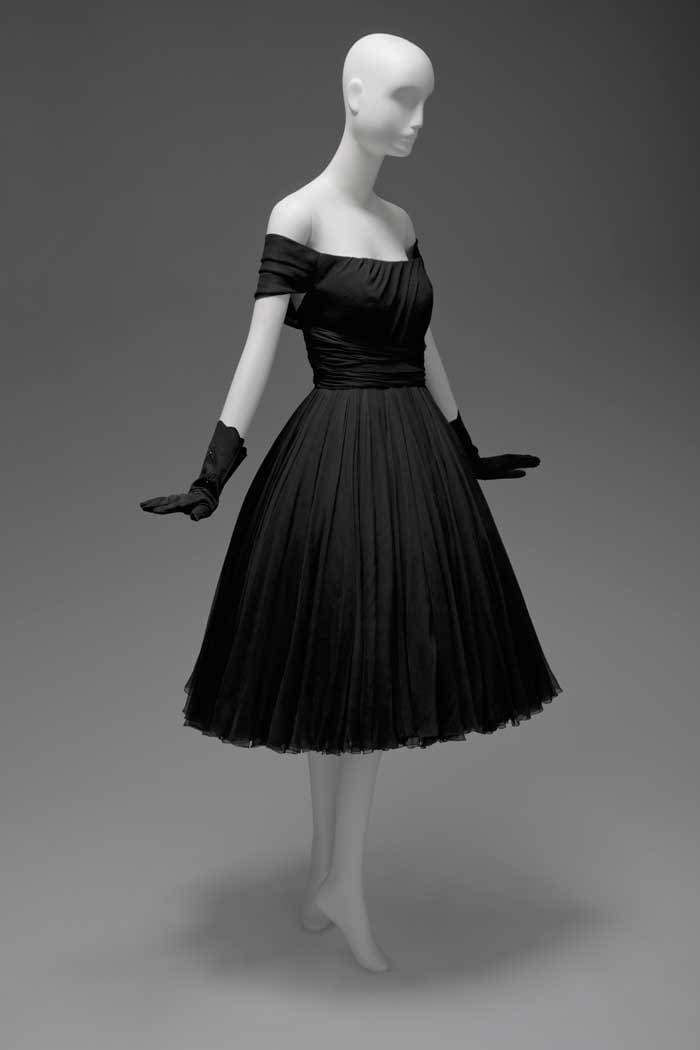
Black chiffon cocktail dress, designed by James Galanos and distributed by Blum’s Vogue, Chicago, Illinois, 1958.
Chicago History Museum/Getty Images
Cocktail dresses ranged from basic sleeveless black styles to wiggle dresses in metallic brocade that were less modest. Also common were designs made of cotton prints that included peekaboo details around the waist and sleeves that ended above the elbow, strapless baby blue chiffon, and purple lace numbers with flared hems and tight waists, accessorized by multiple strings of pearls.
The Sixties and Beyond
By 1960, the consumer-driven cocktail culture fostered by cocktail advertisements, cocktail sets, and martini-printed fabric became part of the American consciousness.
In 1965, Yves Saint Laurent designed a new kind of cocktail dress, the Mondrian, that paid homage to Dutch painter Piet Mondrian and evoked the painter’s abstract canvases. The simple cut, bold color, and geometric lines of Saint Laurent’s dress caused a stir when it was unveiled and was so successful that everyone soon copied it.
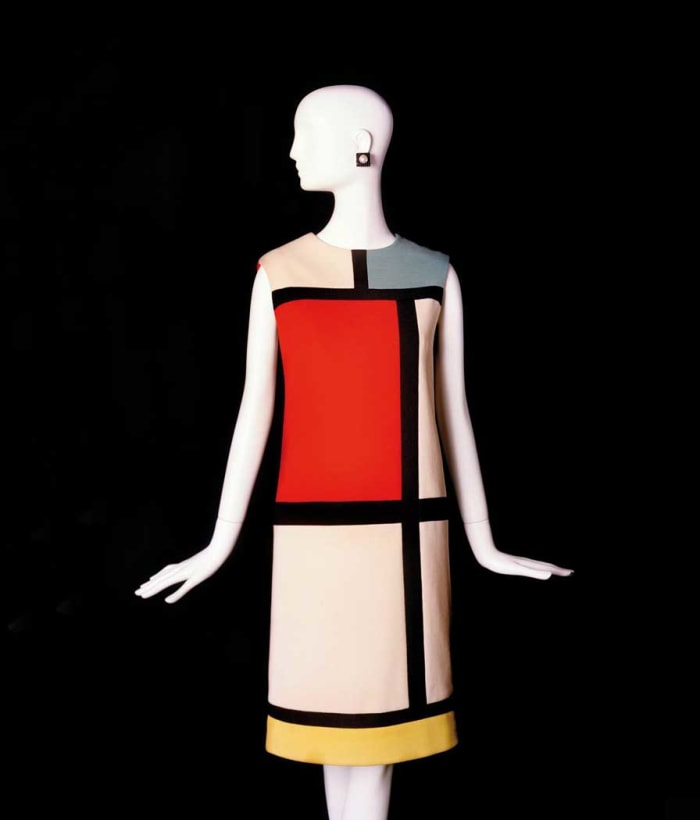
Yves Saint Laurent’s new style of cocktail dress, the Mondrian, caused a stir when he unveiled it in 1965 and was copied everywhere. Inspired by the abstract paintings of the Dutch De Stijl artist Piet Mondrian, Saint Laurent designed a group of bold dresses based on intersecting black stripes and blocks of primary colors. The Mondrian collection became one of the most famous dresses in the history of fashion.
Yves Saint Laurent Museum
American and European designers continued to create cocktail dresses, but women started preferring jumpsuits and palazzo pants to wear instead for the private-party circuits of the following decades.
Cocktail dresses continue to be a staple item in wardrobes but are now considered today to be more formal wear and not limited to a specific social function or time of day.
Keeping women looking stylish while sipping drinks for almost a century, the cocktail dress remains one of the most party-loving pieces in fashion history.
Tips For Collecting Vintage Cocktail Dresses
A classic cocktail dress is a garment worn for occasions that typically take place in the early evening. Although its name stems from “cocktail party,” these dresses are suitable for other events and are generally paired with high heels.
Cocktail dresses first rose to prominence in the 1920s and progressed onward, with each era giving its spin to the fashionable and practical attire.
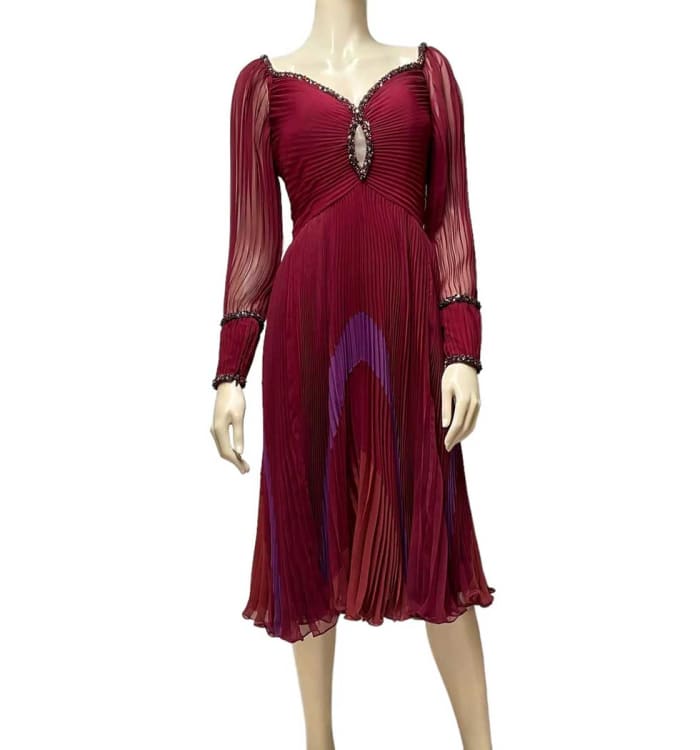
Bob Mackie beaded and pleated chiffon cocktail dress, 1980s; $1,200.
Courtesy of Reoccurring Dreams; rubylane.com/shop/reoccuring-dreams
For collectors, this leaves many vintage options and contemporary ones if that’s more to your taste. Designs vary, but the hemline of most cocktail dresses falls near the knee or calf; some designs from the 1930s are ankle-length. They have also been made in an array of colors. Common fabrics include silks and satins, which distinguish cocktail dresses from day dresses, typically made of gabardines and wool crepes.
Vintage cocktail dresses are fun to collect and wear. Examples made by renowned designers such as Chanel, Christian Dior, Jacques Fath, Norman Norell, Yves Saint Laurent, and Elsa Schiaparelli can also be quite valuable.
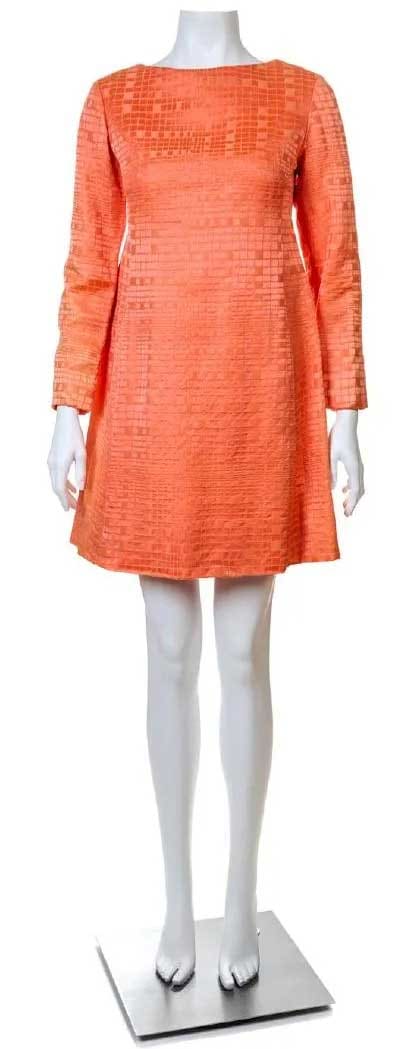
Sometimes you can be lucky and get a great bargain on a Christian Dior dress like this tangerine silk embossed number that sold for $425.
Courtesy of Hindman
Beyond big names, vintage cocktail dresses from high-end department stores can also offer good value for the money. In the 1930s and 1940s, American department stores used the same designs and fashionable fabrics in Paris. Dresses can be found made by store designers who later became famous, such as Sophie Gimbel, who worked in the Salon Moderne for Saks Fifth Avenue. Gimbel gained popularity after World War II and was a leading designer for nearly 40 years.
Learning about the designers who made cocktail dresses in various eras can help ensure you make the right choices. Here are some other things to keep in mind.
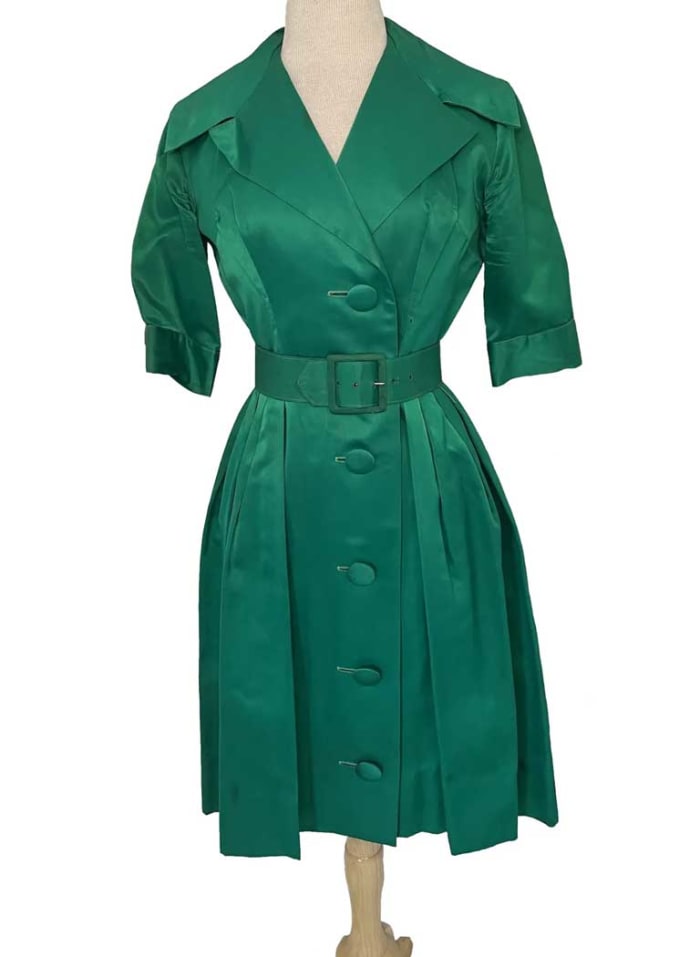
Everything is oversized on this 1950s emerald cocktail dress: giant buttons, giant belt, and a fantastic oversized, shawl collar; $30.
Courtesy of Sweet Ginger Vintage; rubylane.com/shop/sweet-ginger-vintage
Condition
The condition of a dress is essential, especially if you plan to wear it; it should be strong enough to handle use. A dress should have tight seams, and a secure hem, and the fabric should not have any holes or thin areas. If the garment has any embellishments, such as beads, sequins, or rhinestone buttons, they should be securely attached.
Construction
A cocktail dress’ construction and design are also important considerations. Collectors should focus on finding beautiful examples with special details, such as embroidery, hand beading, or delicate lace. The best dresses will ideally have a design emblematic of the era and excellent fabrics, embellishments, and quality.
Sizing
Another essential thing to keep in mind is sizing. Sizes are less important if you only plan to display a dress, but if you plan to wear any cocktail dresses you buy, be aware that there is a vast difference between vintage and modern sizing. According to the fashion site More Fashion, it’s been said that Marilyn Monroe wore a size sixteen, which would be equivalent to a size six today.
Sizes have gotten smaller with each decade, so someone who wore a size ten in the 1940s and a size four in the 1970s would wear a size 00 now. Shopping by size is not a guarantee a dress will fit, but you can have better success if you compare something you want to buy to a similar item you already have in your wardrobe. If buying online, look for measurements taken while the garment was flat.
Prices and Where to Find
Prices for vintage cocktail dresses run the gamut and are anywhere from $10 to tens of thousands. Many good-quality dresses by unknown designers can be found between $50 and $100. Museums worldwide house examples by renowned designers like Dior, and though they are generally not as pricey as one of his evening gowns, when one of his dresses hit the secondary market, collectors can expect to pay between $10,000 to $25,000 on average. However, cocktail dresses made by his design house after his death can generally range between $500 to $1,200.
Vintage cocktail dresses can be found at e-commerce sites such as 1stDibs.com, eBay.com, Etsy.com, and RubyLane.com. Some auction houses also specialize in vintage clothing, including Augusta Auctions and Kerry Taylor Auctions, which have several sales yearly.
Fashion is a powerful way to express yourself, so above all else, collect cocktail dresses you will love for years to come.
YOU MAY ALSO LIKE:
The Story Behind Marilyn Monroe’s Happy Birthday Dress
Rare Gowns Gowns Found in Trunk Unpack Important Fashion History









